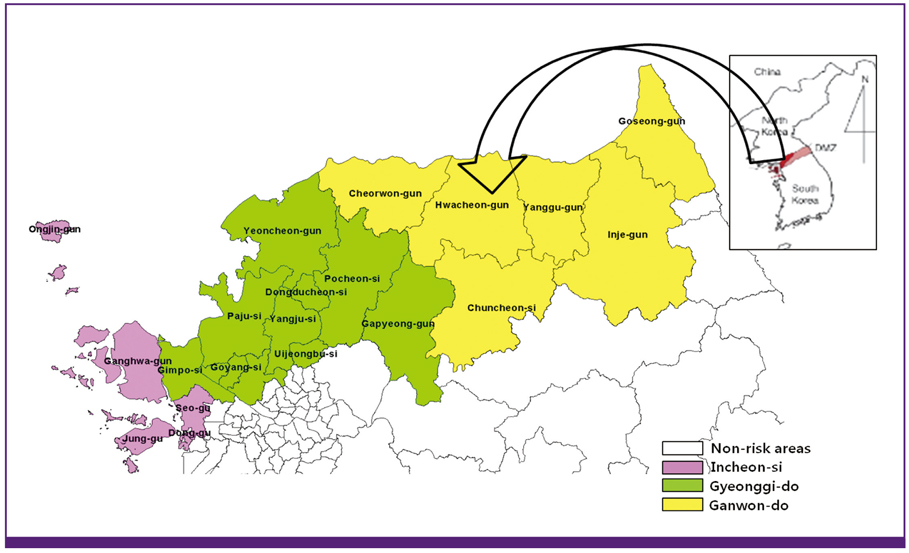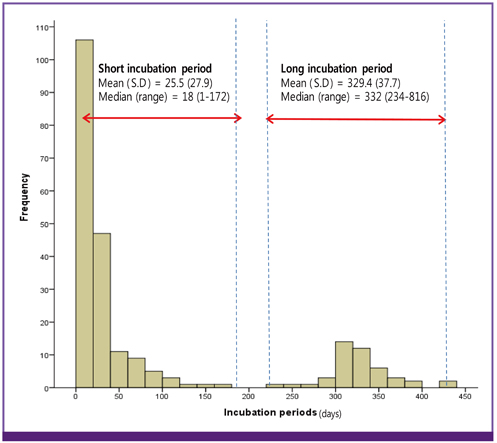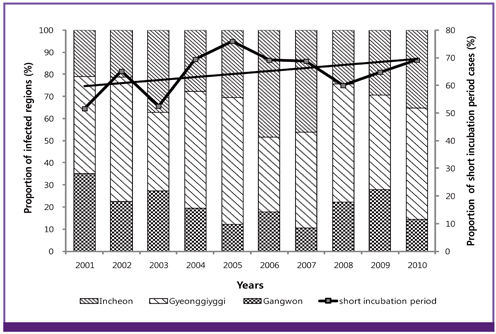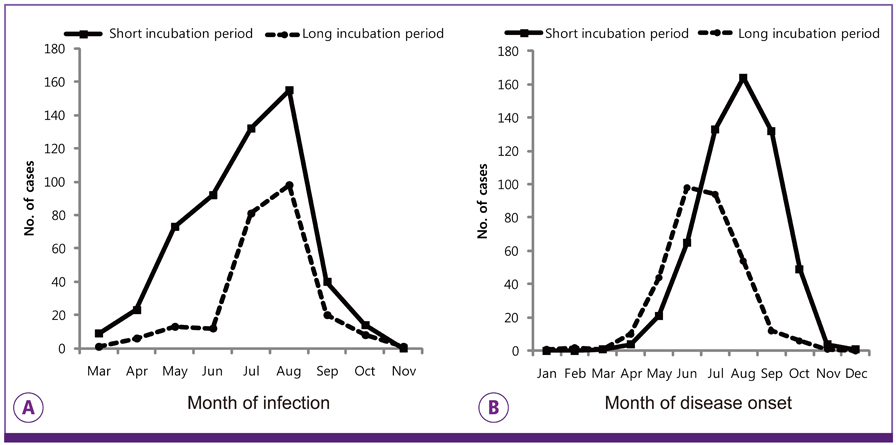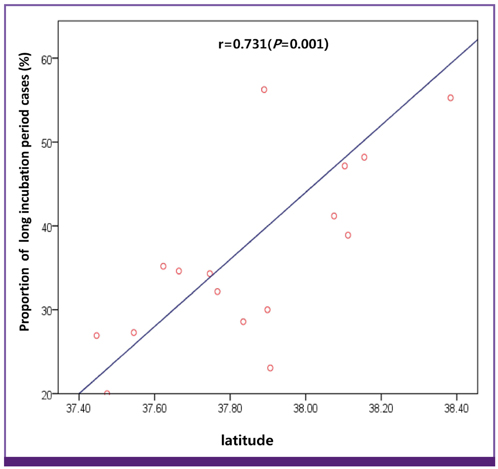Infect Chemother.
2013 Jun;45(2):184-193. 10.3947/ic.2013.45.2.184.
The Long and Short Incubation Periods of Plasmodium vivax Malaria in Korea: The Characteristics and Relating Factors
- Affiliations
-
- 1Division of Epidemic Intelligence Service, Korea Centers for Disease Control & Prevention, Osong, Korea.
- 2Division of Disease Control, Korea Centers for Disease Control & Prevention, Osong, Korea.
- 3Department of Preventive Medicine and Public Health, Ajou University School of Medicine, Suwon, Korea. free5293@gmail.com
- KMID: 2284999
- DOI: http://doi.org/10.3947/ic.2013.45.2.184
Abstract
- BACKGROUND
The cases of Plasmodium vivax malaria in Korea are mixed with long and short incubation periods. This study aims to define clinico-epidemiologic chracteristcs of Plasmodium vivax malaria in Korea.
MATERIALS AND METHODS
We selected the civilian cases infected with P. vivax malaria in Korea from the epidemiological investigation data of 2001 to 2010, whose incubation periods could be estimated. The long and short incubation periods were defined by duration of infection and onset time, and the cases were compared by demographic factors and clinical symptom, infection and onset time. The correlation was analyzed between the proportion of cases in the infected region with the long incubation period and meteorological factors along with latitude.
RESULTS
The length of the mean short and long incubation periods for the cases were 25.5 days and 329.4 days, respectively. The total number of the study subjects was 897, and the number cases of short and long incubation periods was 575 (64.1%) and 322 (35.9%), respectively. The aspect of incubation period showed a significant difference by region of infection; there was a higher proportion of long incubation period infection cases in Gangwon-do than in Gyeonggi-do and Incheon. The proportion of long incubation period cases showed significant correlation with latitude and temperature of August and September of the infected regions.
CONCLUSIONS
Incubation period of P. vivax malaria in Korea showed significant difference by infected region, infection and onset time and the proportion of long incubation period cases showed significant correlation with latitude and meteorological factors of the infected regions.
Keyword
Figure
Cited by 1 articles
-
Clinical Characteristics of Vivax Malaria Outside Northern Gyeonggi Province Korea
Jae Hoon Lee, Young-Jin Lee, Jeong-Hwan Hwang, Chang-Seop Lee
Infect Chemother. 2014;46(1):59-61. doi: 10.3947/ic.2014.46.1.59.
Reference
-
1. Sinden R, Gilles H. Warrell DA, Gilles HM, editors. The malaria parasites. Essential malariology. 2002. 4th ed. New York: Oxford University Press;8–34.2. Cox-Singh J, Singh B. Knowlesi malaria: newly emergent and of public health importance? Trends Parasitol. 2008. 24:406–410.
Article3. Yeom JS, Park JW. Status of vivax malaria after re-emergence in South Korea. Infect Chemother. 2008. 40:191–198.
Article4. Park JW, Klein TA, Lee HC, Pacha LA, Ryu SH, Yeom JS, Moon SH, Kim TS, Chai JY, Oh MD, Choe KW. Vivax malaria: a continuing health threat to the Republic of Korea. Am J Trop Med Hyg. 2003. 69:159–167.
Article5. Park JW. Status of Plasmodium vivax malaria in the republic of Korea after reemergence. Hanyang Med Rev. 2010. 30:176–186.
Article6. Kho WG. Reemergence of Malaria in Korea. J Korean Med Assoc. 2007. 50:959–966.
Article7. Shute PG, Lupascu G, Branzei P, Maryon M, Constantinescu P, Bruce-Chwatt LJ, Draper CC, Killick-Kendrick R, Garnham PC. A strain of Plasmodium vivax characterized by prolonged incubation: the effect of numbers of sporozoites on the length of the prepatent period. Trans R Soc Trop Med Hyg. 1976. 70:474–481.
Article8. Korea Centers for Disease Control and Prevention. Interim evaluation of efficacy of 2010 malaria eradication project. 2008. Seoul, Korea: KCDC;9–72.9. Tiburskaya NA, Vrublevskaja OS. The course of infections caused by the North Korean strain of Plasmodium Vivax. 1977. Geneva: WHO;1–19.10. Nishiura H, Lee HW, Cho SH, Lee WG, In TS, Moon SU, Chung GT, Kim TS. Estimates of short- and long-term incubation periods of Plasmodium vivax malaria in the Republic of Korea. Trans R Soc Trop Med Hyg. 2007. 101:338–343.
Article11. Nah K, Choi I, Kim Y. Estimation of the incubation period of P.vivax Malaria in Korea from 2006 to 2008. J Korean Data Inf Sci Soc. 2010. 21:1237–1242.12. Oh MD, Shin H, Shin D, Kim U, Lee S, Kim N, Choi MH, Chai JY, Choe K. Clinical features of vivax malaria. Am J Trop Med Hyg. 2001. 65:143–146.
Article13. Warwick R, Swimer GJ, Britt RP. Prolonged incubation period of imported P. vivax malaria in London. J R Soc Med. 1980. 73:333–336.
Article14. Shute PG. Latency and long-term relapses in benign tertian malaria. Trans R Soc Trop Med Hyg. 1946. 40:189–200.
Article15. Yoo DH, Park MY, Shin E-H, Chang KS. Malaria vector mosquitoes in nine Koran army-base camps near Dimilitarized zone in the Republic of Korea. Am J Trop Med Hyg. 2013. [In press].16. Korea Centers for Disease Control and Prevention. The white book on infections disease control. 2012. Osong, Korea: KCDC;381–382.17. Korea Centers for Disease Control and Prevention. Surveillance of vector mosquitoes and investigation of vivax parasites in non-endemic areas in Korea. 2012. Osong, Korea: KCDC;2–40.18. Park JW. Changing transmission pattern of Plasmodium vivax malaria in the Republic of Korea: relationship with climate change. Environ Health Toxicol. 2011. 26:e2011001.19. Martens P, Kovats RS, Nijhof S, de Vries P, Livermore MT, Bradley DJ, Cox J, McMichael AJ. Climate change and future populations at risk of malaria. Global Environmental Change. 1999. 9:S89–S107.
Article20. Bray RS, Garnham PC. The life-cycle of primate malaria parasites. Br Med Bull. 1982. 38:117–122.
Article21. White NJ. Determinants of relapse periodicity in Plasmodium vivax malaria. Malar J. 2011. 10:297.22. Korea Meteorological Administration. Annual Climatological Report 2001~2010. 2010. Seoul, Korea: KMA.23. Brasil P, de Pina Costa A, Pedro RS, da Silveira Bressan C, da Silva S, Tauil PL, Daniel-Ribeiro CT. Unexpectedlylongincubationperiod of Plasmodium vivax malaria, in the absence of chemoprophylaxis, in patients diagnosed outside the transmission area in Brazil. Malar J. 2011. 10:122.
- Full Text Links
- Actions
-
Cited
- CITED
-
- Close
- Share
- Similar articles
-
- Changing Transmission Pattern of Plasmodium vivax Malaria in the Republic of Korea: Relationship with Climate Change
- Multiple Cerebral Infarcts Following Acute Plasmodium vivax Infection
- A Case of Plasmodium vivax Malaria Associated with Autoimmune Hemolytic Anemia
- Three cases of vivax malaria showing atypical clinical course
- A case of Plasmodium vivax malaria occurring during a school excursion to Pocheon-gun

